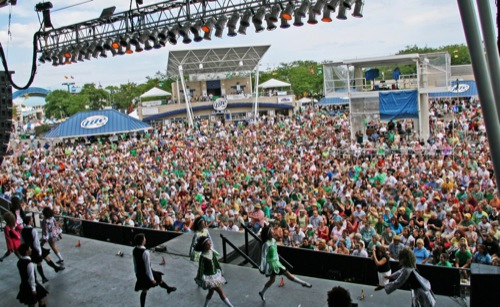
Milwaukee’s Irish fest is the largest in the world outside of Ireland, courtesy Visit Milwaukee
International History
Although the festivals provide visitors an opportunity to sample Milwaukee’s extensive international flavor, the city itself is rich in international history.
German immigrants flooded Wisconsin in the middle and late 1800s. During the 1840s, more than 1,000 Germans arrived in Milwaukee each week, and the city’s population was one-third German by 1850.
That strong German heritage is still evident today. Old World Third Street is home to Usinger’s Sausage, which still sells sausages and smoked meats made from family recipes that have remained unchanged since 1880. Mader’s Restaurant, which Charles Mader founded as “The Comfort” in 1902, is renowned for both its German cuisine and its $3 million collection of art, antiques and Medieval armor. The street is also home to Milwaukee Brat House and the Wisconsin Cheese Mart, which was founded in 1938.
“I call that area ‘my food court,’” Dobrzynski said. “There are a lot of things to do on that street.”
Milwaukee RiverWalk, the three-mile paved pedestrian pathway along the river, spans three distinct areas: the Beerline section to the north, the Third Ward section on the south end, and the center strip known as the Downtown RiverWalk.
The downtown section, which runs alongside a few blocks of Old World Third Street, also leads people to the steps of the Milwaukee River Cruise Line. The company takes passengers onto the Milwaukee River and Lake Michigan on its Edelweiss boats, which are European-style, flat-bottom vessels. Tour options include the Milwaukee Beer and Brat Cruise and the Historic Milwaukee Boat Tour, which features a narrated history of Milwaukee immigrants, manufacturing and brewing.
Brewing Tradition
The city’s deep-rooted German heritage is inseparable from its longstanding brewing tradition, and growing interest in beer brewing is spurring more visits to the city’s historic Pabst brewery and Pabst mansion, Dobrzynski said.
German immigrant Jacob Best established his brewery in 1844, first as the Empire Brewery, then as Best and Co. Best’s son, Phillip Best, took control of the brewery in 1860, and Phillip Best’s son-in-law, Frederick Pabst, joined the company in 1886. Pabst changed the name of the brewery to his own in 1889, said Jim Haertel, who now owns Best Place at the Historic Pabst Brewery.
When the Pabst brewery closed in December 1996, it sat vacant until Haertel’s offer to buy the property was accepted in 2001. But legal issues arose, and several years passed before Haertel and his partners were able to take possession of their buildings.
Today, Haertel calls himself the “chief steward and historic tour guide” and gives about 80 percent of the tours at Best Place. Although the buildings where the brewing was done are not open to the public, guests experience Blue Ribbon Hall; parts of the administrative building, including Pabst’s office; and two courtyards. Each tour starts with a Pabst or Schlitz beer, or a Sprecher root beer.
Blue Ribbon Hall was built as a public school in 1858, and Pabst Brewing Co. bought it in 1890. It wasn’t until the early 1940s that the company converted it into a German beer hall, complete with murals by famed Chicago artist Edgar Miller that remain untouched today.
The tour includes retro beer commercials from the 1960s and 1970s and a stop in each of the two courtyards, where guests can see a bronze statue of Capt. Fredericki Pabst and a statue of King Gambrinus, the legendary king of Flanders and patron saint of beer brewing.
“We don’t give a brewery tour; we give a beer history tour,” Haertel said. “That’s what makes us different. It’s not so much traipsing around the brewery learning how to make the beer. It’s being in a really unique and historic place.”
Pabst’s opulent 1892 mansion has also been transformed into a historic museum that is open for tours, and packages are available to tour both the Pabst mansion and Best Place.










